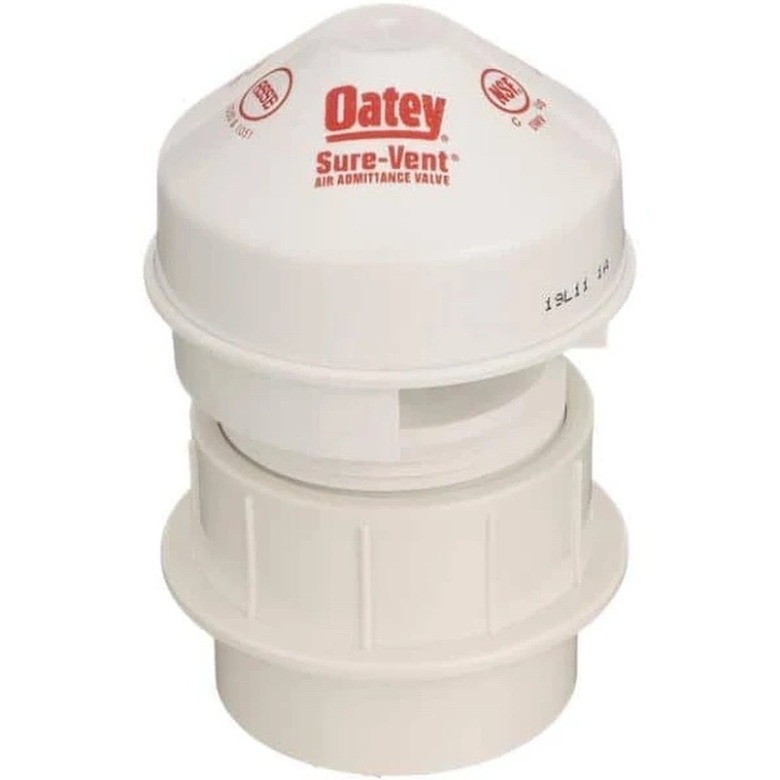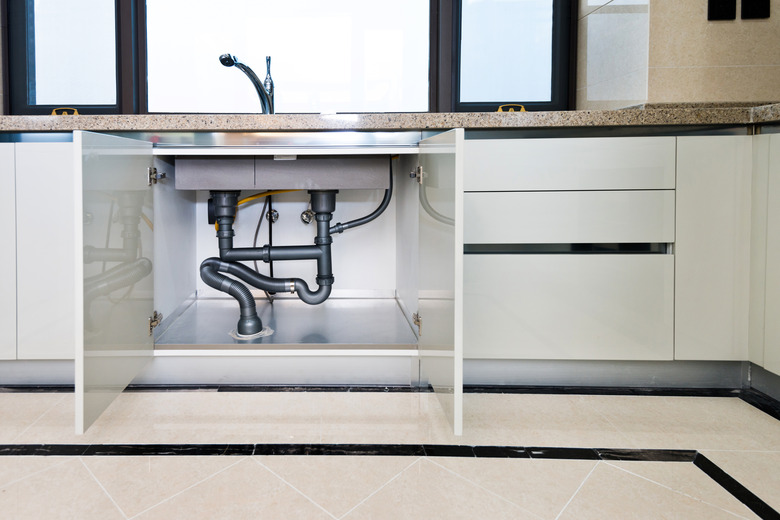Installing An Air Admittance Valve: Everything You Should Know
We may receive a commission on purchases made from links.
The purpose of an air admittance valve, or AAV, is to provide a viable way to vent a fixture drain P-trap in the event that hooking up the drain to the building's vent network is prohibitively costly or difficult. Air admittance valves can be used in installations such as a kitchen island sink or a bathroom sink in a basement or a room on the side of the house opposite the vent stack. AAVs are handy alternatives to conventional venting and definitely make a plumber's life easier, but they aren't legal everywhere. If you're a remodeler who is fairly new to plumbing, it helps to understand the AAV, its importance as an alternative venting solution and how to install one.
How an Air Admittance Valve Works
How an Air Admittance Valve Works
What do you do when you can't install standard vent piping? If your local codes allow it, you install a Studor minivent (or a similar product), also known as an air admittance valve, which has been an option in the United States since 1986.
An air admittance valve is a cylindrical, dome-topped plumbing fitting about 3 or 4 inches high and sized to fit on 1 1/2- or 2-inch drain lines. It is typically added to the horizontal pipe between the fixture P-trap and the drain line. Inside the dome is a spring-loaded valve that is normally closed. When water flows through the trap and into the drain line, it creates negative pressure that pulls the valve open, allowing air to enter the pipe. The air breaks any suction effect inside the pipe that slows drainage (much like holding your thumb over a straw full of liquid allows you to "magically" lift the straw without the liquid draining out). The valve springs shut to seal the drain when water stops flowing. This stops sewer gases that rise up through the drain pipe from flowing into the building.
Air admittance valves are usually made of PVC and have screened vents, and each is rated according to the number of drain fixture units (DFU) it can handle. A bathroom sink is the most common application, and it counts as 1 DFU, but AAVs that can handle from 20 to 500 DFU are available and can vent larger fixtures or more than one fixture at a time.
Pros and Cons of AAVs
Pros and Cons of AAVs
As an alternative to direct venting (with a vent pipe that goes through the roof), an AAV offers these benefits:
- A solution to difficult venting problems. They are especially useful for island sinks, for which a loop vent is the alternative.
- Savings in labor and materials. Instead of running pipes through the walls, a plumber simply has to glue a single, inexpensive fitting to the P-trap waste arm.
- Longevity and easy replacement. An AAV typically comes with a lifetime warranty and lasts 200,000 cycles, or about 20 years. When one fails, it can simply be cut out and replaced with a new one.
- Reduction in roof penetrations. An AAV eliminates the need to run a separate vent line for an isolated drain. That means one less hole in the roof that could potentially leak.
AAVs aren't without their problems, however:
- An AAV is a mechanical device, and mechanical devices can fail. If it gets stuck in the open position, an AAV could allow sewer gases into the house.
- Some local codes do not allow air admittance valves.
- AAVs are vulnerable to damage by rodents and incursion by insects that can interfere with the valve mechanism.
Venting Is Critical
Venting Is Critical
Plumbing vents were developed soon after the introduction of the P-trap in the mid-1800s. The purpose of a P-trap is to hold a pool of water that seals noxious and flammable sewer gases in the pipes, but early traps had a habit of emptying whenever water flowed through the drain. The reason this happened is that flowing water creates negative pressure that sucks water out of the traps, just as you can draw water up a straw by sucking it.
Drain, waste and vent requirements are written into every building and plumbing code, such as the International Residential Code (IRC), the International Plumbing Code (IPC) and the Uniform Plumbing Code (UPC). The most basic code requirement is that every fixture drain must have a P-trap and a vent, with no exceptions. If air can't get into the drain pipe to break the suction created by flowing water, water slows down or stops altogether, and it empties the trap. You usually hear gurgling from a drain with poor venting, which is the sound made by air being sucked through the trap water by the negative pressure in the pipes. An AAV performs the same function as a conventional vent pipe to prevent these problems.
Check Your Local Codes Before Installing an AAV
Check Your Local Codes Before Installing an AAV
Many state and local plumbing authorities prohibited the use of AAVs when they first appeared, and while some authorities have since lifted restrictions, others haven't. For example, AAVs remain illegal in Minnesota because the current plumbing code, which was published in 2015, contains no language rescinding the prohibition in earlier versions.
The situation varies from state to state. The 2016 California Plumbing Code is based on the UPC and contains no language related to AAVs, making it important to consult with local authorities before installing one. On the other hand, states such as Florida, Michigan and New York typically allow AAVs because their plumbing codes conform to the IPC, which contains a section on their use. Your plumbing system probably won't get red-tagged if you illegally install an AAV, but you could run into problems with home inspectors when it's time to sell the house, so check first.
To be legal, an air admittance valve must conform to standards established by the International Association of Plumbing and Mechanical Officials (IAPMO) and the American Society of Sanitary Engineering (ASSE) in section 1050 of their testing protocols. Most major brands of AAVs are identified as ASSE 1050 compliant on the packaging. If you choose an off brand, make sure this compliance is listed.
Things Needed
How to Install an Air Admittance Valve
How to Install an Air Admittance Valve
The most common way to install an AAV on a sink drain is to tie it into the horizontal waste arm between the P-trap and the drain outlet in the wall behind the sink. You can also install an AAV on a riser connected at the point where the waste arm drops to the drain much like you would install a conventional vent pipe. This procedure is for installation on a horizontal waste arm.
1. Measure Your Clearances
Measure the length of the horizontal pipe (the waste arm) between the P-trap and the wall using a tape measure. The minimum horizontal distance between the AAV and the fixture drain trap outlet is 4 inches, so you need at least that much clearance.
The vertical clearance between the bottom of the AAV and the top of the trap arm must be at least 4 inches for the device to work properly. There is no specific requirement for vertical or horizontal clearances from the sink, the countertop or the wall as long as the AAV is accessible for repairs or servicing, and it has sufficient airflow.
2. Mark the Pipe and Cut It
Using a felt-tip pen, make a mark on the horizontal waste arm at a distance at least 5 inches from the trap outlet to allow for overlap while gluing. Remove the trap arm and cut the pipe at this mark using a hacksaw.
3. Glue In a Straight Tee
Glue the main section of the waste arm to one of the horizontal ports of a straight tee using PVC pipe primer and cement. Measure the distance between the horizontal ports of the tee, cut this amount from the remaining (straight) portion of the waste arm and glue the resulting piece into the other horizontal port of the tee.
4. Install the Valve
Cut a 5- to 6-inch piece of PVC pipe (the same size as the waste arm) and fit it into the vertical port of the tee. Fit the AAV to the top of this vertical pipe. Double-check the distance from the bottom of the valve to the top of the waste arm to make sure it's at least 4 inches. When all looks good, glue the pipe to the tee and then glue the AAV to the pipe.
5. Reinstall the Pipe
Reinstall the waste arm assembly back onto the P-trap so the AAV points straight up. Use a torpedo level to plumb it. The valve can't be installed more than 15 degrees from vertical or it won't work. Run some water in the sink to make sure the drain works properly and there are no leaks at any of the pipe joints.
Important Things to Keep in Mind
Important Things to Keep in Mind
An air admittance valve must always be accessible because you may have to service or replace it, so if you install it behind a sink wall, you must provide a removable access panel. The AAV must also be in a location that allows air to enter the valve, so it can't be in an airtight enclosure. Most sink cabinets satisfy this requirement.
You can use an AAV as a stack vent to provide venting for more than one fixture. When you do this, the AAV must rise at least 6 inches above the flood level of the highest fixture being vented, and the valve must be accessible. You can extend the vent stack into the attic; in this case, the distance between the AAV and the attic floor must be at least 6 inches.
A dishwasher drain typically connects to the drain tailpiece of a kitchen sink, and the dishwasher wastewater empties through the sink P-trap. So, if the sink drain is serviced by an AAV, the dishwasher drain is properly vented as long as the AAV is installed the way it should be. A washing machine, on the other hand, has its own drain trap connected to the standpipe into which the washing machine drain hose empties. You can use an air admittance valve to vent this trap, but you should choose a high-DFU one that is designed for this application.



